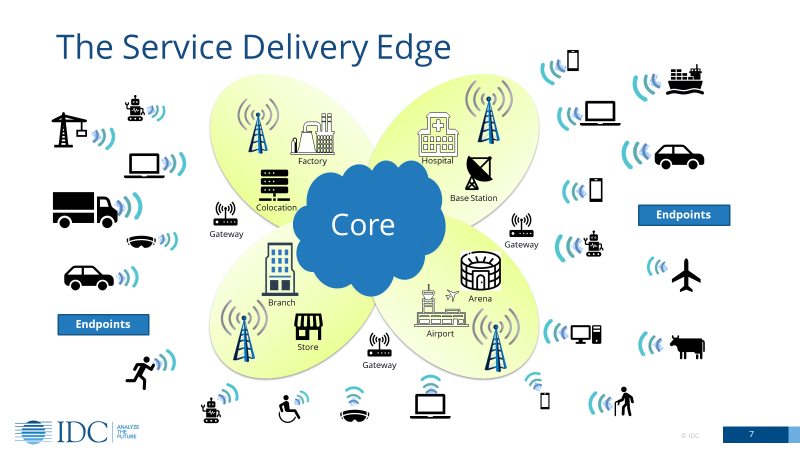My colleagues and I spend a great deal of time thinking about the Edge, and how it will influence developments in the IT industry over then next few years. Several of my colleagues just published a great IDC Market Perspective, making it clear that we believe the edge represents a new frontier in the convergence of infrastructure such as computing and data to deliver much faster time to value.
They also made a critical point. The edge isn’t a singular entity or a singular market. At IDC’s Directions, I’ll be digging deeper into one of the most important, though often underappreciated parts of the edge conversation: the service delivery edge.
Any conversation related to the edge must start with the 31 billion endpoints (things) that IDC believes will be connected around the world by 2021. It also must acknowledge the importance of the 39,000 core datacenters (enterprise, colocation, and cloud) where global data consolidation, deep analysis, and long term data storage will mostly occur. In between these two extremes is the service delivery edge.

This part of the Edge is anywhere and everywhere that we work, play and live. It’s also where we want to interact with and take advantage of all these smart things that people keep creating. By 2021, IDC expects there to be over 7 million service deliver edge locations that contain significant compute, storage and network infrastructure. They will be optimized for extreme low latency, local service resiliency, and local data control that’s required to deliver an optimal digital experience in a specific location at a specific time.
Delivering Improved Customer Experience Is the Edge of Digital Transformation
Think about any hospital, large entertainment/hospitality venue, or major retail store that is attempting to dramatically improve customer experience by providing a digitally optimized experience:
- They need to build and continually enhance a high performance/location-aware wireless network fabric for employees, customers, and all the smart devices in use in the space.
- They need to provide and secure local storage/caching of critical data to ensure rapid local access and data availability (in case of wide area network degradation).
- They need to have access to local dense computing resources that enable use of inferencing and other machine learning processes for real time services like customer sentiment analysis.
The amount of IT infrastructure required in any one of these service delivery edge locations, along with the millions of other in industries such as a manufacturing, transportation, and energy, will be quite substantial. Smaller locations may make do with a rack of IT gear, but in many circumstances, assets will be in micro-datacenters within specific buildings or in nearby colocation facilities.
To make life more interesting, the service delivery edge isn’t simply about deploying/managing infrastructure in individual buildings, arenas, or cities. It’s about deploying the same service in tens, hundreds, or thousands of locations without losing control of physical assets and the data/applications running on them. Assuring consistency in deployment and ongoing operations depends upon aggressive use of standardized software defined and cloud-native software technologies. And just to make it interesting, most entities need to do this without requiring the local presence of IT staff.
5G is an Accelerator and Proofpoint for IT at the Edge
The rollout of 5G, which IDC believes will play a critical role in accelerating all edge developments, is perhaps the ultimate example of the opportunities/challenges associated with building out a massive service delivery edge in individual cities, states or entire countries. It’s not surprising, then, that IDC predicts that $57 billion will be spent to build out the 5G service delivery infrastructure in the next 4 years.
The need for significant IT asset deployment in individual edge locations and the need to replicate those deployments in over 7 million locations over the next 4 years adds up to lots of opportunities for infrastructure hardware and software providers, as well as the cloud/managed service providers who will help enterprise deploy and maintain these local service delivery assets.
Transitioning from Exclusive to Normal
I see one potential fly in the ointment when it comes to the anticipated service delivery edge expansion. It’s not because these organizations are losing interest in transforming their businesses through greater investments in digital services. They are committing treasure and intellectual capital to pilot/launch some amazing new services in the next year.
The challenge is that they don’t know how to transition from delivering “exclusive” pilot services for a limited set of customers services in a limited number of locations to making these services a normal part of business. My colleagues and I have had many conversations with true innovators in areas like customer experience and predictive systems operations who launched unique pilots, but when the time came to convert these into a normal experience at a national or global level, they couldn’t move forward.
This is not a technology problem. It won’t be fixed with a new compute, memory, storage, or network chip. It’s a delivery problem. We in the IT industry are great at delivering infrastructure into large, relatively standardized core datacenters, but when it comes to designing, deploying and sustaining a wide range of vertically and functionally different service delivery platforms across many locations a lot of work remains to be done. Infrastructure product and service providers must focus on three key requirements if they want to capitalize on the edge IT opportunity:
- Deliver frictionless connectivity within a location and from the edge to the core through use of 5G and virtualized network functions
- Enable frictionless asset deployment with consumption-based solutions like Local Cloud-as-Service HW/SW bundles and virtual CPE
- Provide frictionless control based on an AI-enhanced autonomous IT foundation which both eliminates the need for IT staff at edge locations and improves remote asset use and reliability
Want to learn more about the service delivery edge and technologies like 5G, LCaaS, and autonomous IT? Join us at IDC Directions, in either our Santa Clara or Boston locations.




